RS Ophiuchi slows its fading. On August 8th the recurrent nova RS Ophiuchi lept from its normal magnitude 11.2 to 4.8, dim naked-eye brightness, after 15 years of simmering quietly near minimum. It fading rapidly at first, then much more slowly. As of August 26th it had remained about magnitude 8.0 for four days and was reddening. See Bob King's Recurrent Nova RS Ophiuchi Just Blew its Top! with finder charts and comparison stars. Ophiuchus is ideally placed high in the early evening sky.
Nova Cassiopeiae 2021, meanwhile, has bounced around in brightness ever since it erupted from 15th magnitude to 7.7 last March. Its biggest bumps were to magnitude 5.5 in early May and 6.0 around July 27th. As of August 26th it also had been holding at 8.0 for several days, after it dipped to 8.6 earlier in August. Cassiopeia too is excellently placed in the evening sky. Charts and comparison stars.
FRIDAY, AUGUST 27
■ Whenever bright Vega crosses nearest your zenith, as it does soon after dark now, you know the Sagittarius Teapot is at its highest due south.
Two hours later when Deneb crosses closest to the zenith, it's the turn of little Delphinus and boat-shaped Capricornus down below it to stand at their highest due south. This season, of course, Capricornus is far outshone its guests Jupiter and Saturn.
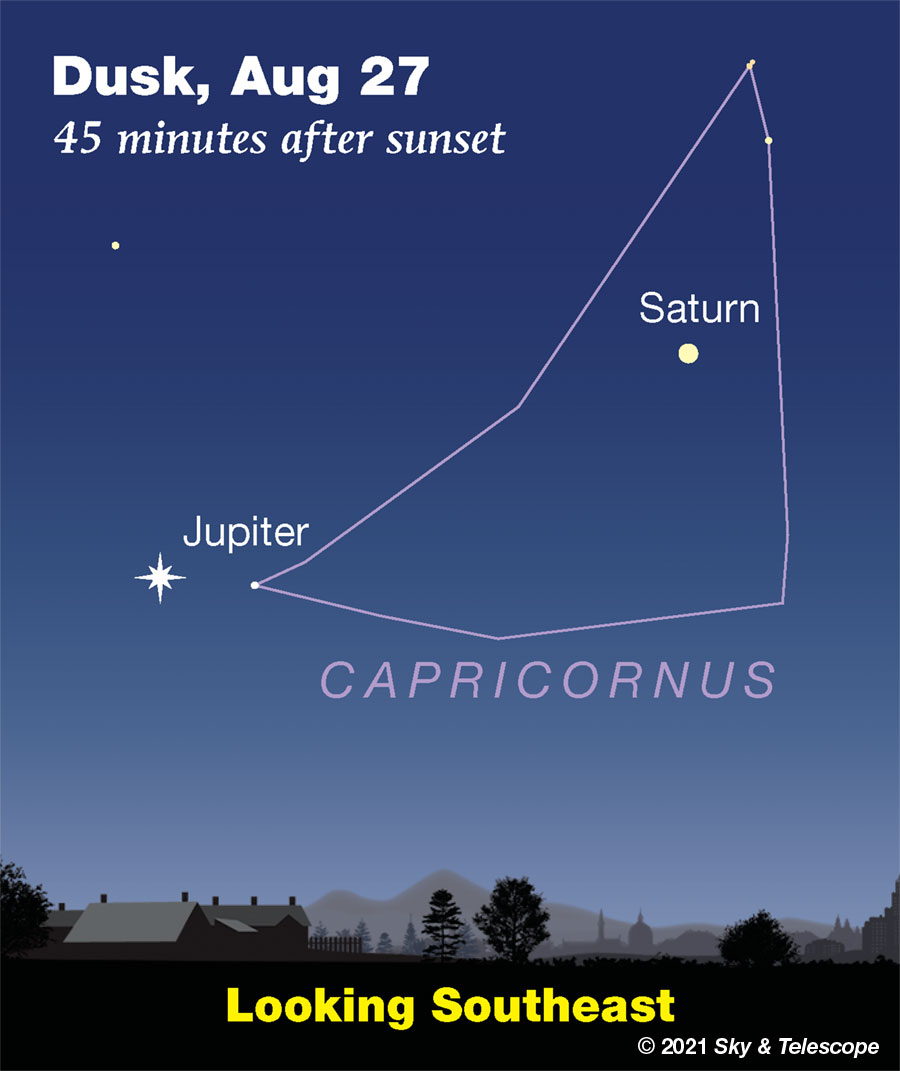
SATURDAY, AUGUST 28
■ Now that the Moon is out of the evening sky, this week is prime Milky Way time! After dark, the Milky Way runs from Sagittarius in the south, up and a bit left left across Aquila and Cygnus high overhead, and on down through Cassiopeia to Perseus low in the north-northeast.
Cygnus sports the Cygnus Star Cloud, one of the Milky Way's richest areas. Explore in depth all through here with binoculars or a small scope using Matt Wedel's "Touring Cygnus with Binoculars" article and big chart in the September Sky & Telescope, starting on page 34.
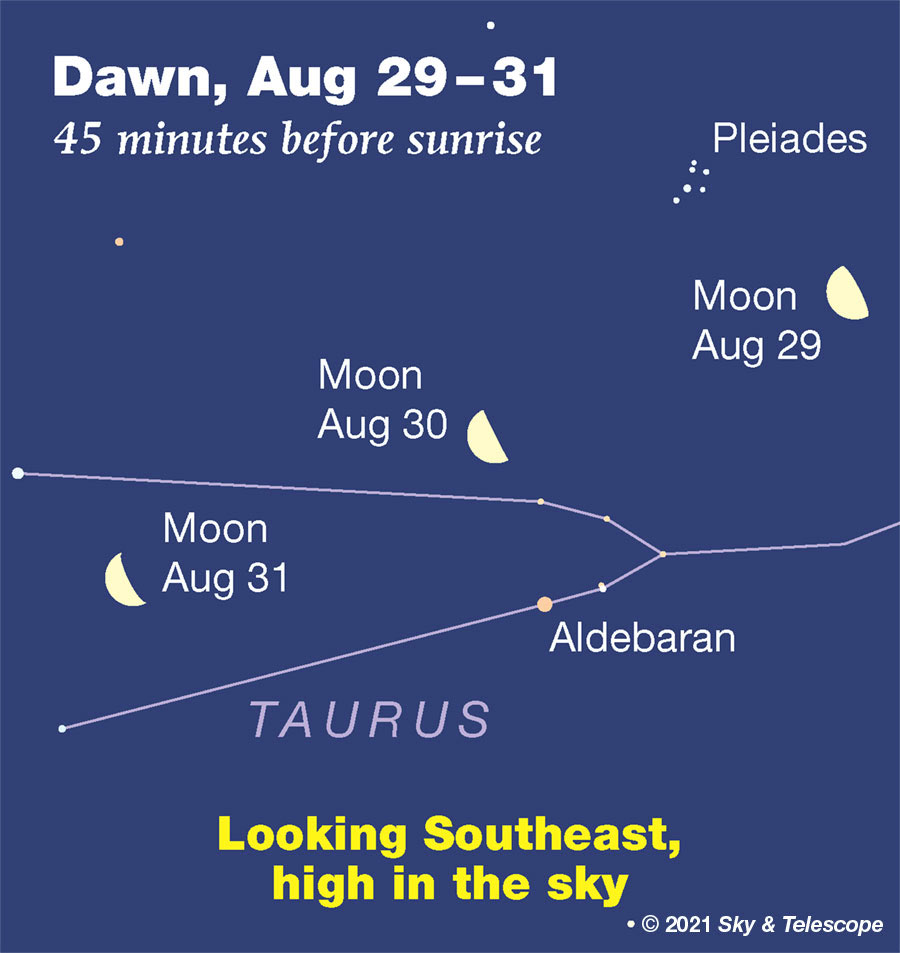
SUNDAY, AUGUST 29
■ Last-quarter Moon tonight (exactly last-quarter at 3:13 a.m. August 30th EDT). The Moon rises around 11 or midnight local time. It's in Taurus, between the Pleiades cluster above it and, once it climbs high enough, orange Aldebaran below it. By early dawn on the 30th the scene shifts somewhat, as shown above.
MONDAY, AUGUST 30
■ Late these evenings as autumn approaches, Fomalhaut, the Autumn Star, makes its inevitable appearance above the southeast horizon. Its rising time will depend on where you live. But by about 10 or 11 p.m. you should have no trouble spotting it low in the southeast; just find an open view in that direction. This year Fomalhaut is easier to locate than usual: Look about two fists below Jupiter and a bit left.
TUESDAY, AUGUST 31
■ A sign of the advancing season: Cassiopeia is high in the northeast, its W pattern tilting up. And below it, starry Perseus is reaching up.
The highest part of Perseus includes the wintry Double Cluster. To find it, look below the lowest two stars of the Cassiopeia W (they're the faintest two), by somewhat more that the distance between them. You're looking for what seems like a small spot of enhanced Milky Way glow. Binoculars or a finderscope will help you detect the Double Cluster even through a fair amount of light pollution. The pair is a glory in a telescope.
WEDNESDAY, SEPTEMBER 1
■ As August wanes and nights begin to turn chilly, the Great Square of Pegasus looms up in the east, balancing on one corner. Its stars are only 2nd and 3rd magnitude, and your fist at arm's length fits inside it.
From the Square's left corner extends the main line of the constellation Andromeda: three stars (including the corner) about as bright as those forming the Square.
This whole giant pattern was named "the Andromegasus Dipper" by the late Sky & Telescope columnist George Lovi. It's shaped sort of like a giant Little Dipper with an extra-big bowl, and it's currently lifting its contents upward.
THURSDAY, SEPTEMBER 2
■ The actual Little Dipper, meanwhile, is tipping over leftward in the north. It's only 40% as long as the Andromegasus Dipper, and most of it is much fainter. As always, you'll find that it's oriented more than 90° counterclockwise compared to Andromegasus. It's currently dumping its contents out.
■ Low in the northwest or north at the end of summer twilights, would you recognize noctilucent clouds if you saw them? They're the most astronomical of all cloud types, with their extreme altitude and formation on meteoric dust particles. And they're fairly rare — though becoming more common in recent years as the atmosphere changes. See Bob King's article.
■ Before and during early dawn Friday morning the 3rd, the waning crescent Moon hangs below Castor and Pollux in the east. Far to the right of this tableau, Orion has already risen high to warn that winter is coming.
Look far beneath Orion for Sirius. Between Sirius and the Moon shines Procyon.
FRIDAY, SEPTEMBER 3
■ The coming of September means that Scorpius, the proudly starring constellation of the southern sky in July, is tilting over and lying low in the southwest after dark, preparing to bed down and drift off for the season.
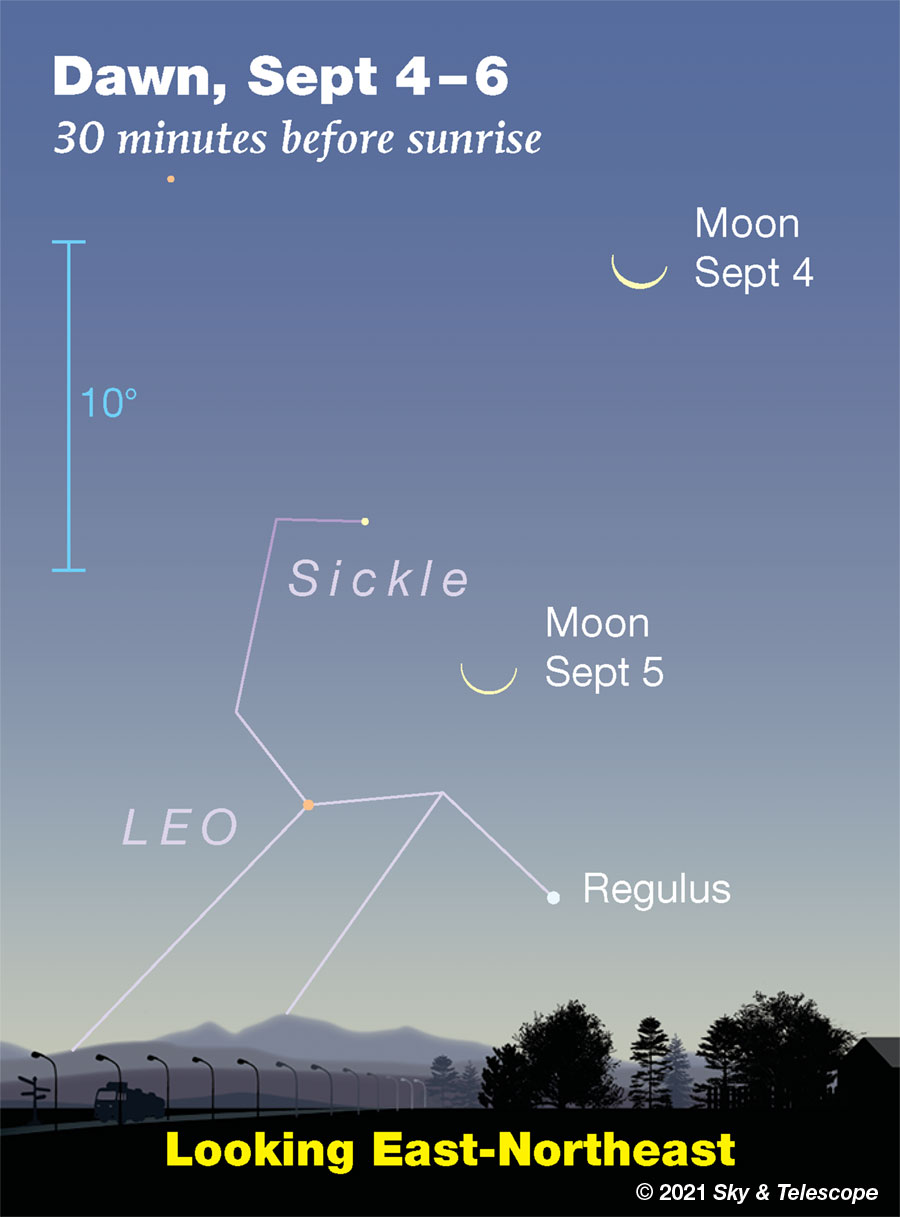
SATURDAY, SEPTEMBER 4
■ Look carefully at Venus low in the west-southwest as twilight fades. Tonight Spica, only 1/100 as bright, glimmers 1.8° to Venus's lower left.
Tomorrow they'll be 1.6° apart.
This Week's Planet Roundup
Mercury (magnitude 0.0) is very deep in the sunset, about 16° lower right of Venus all week. You might have a chance at it with binoculars or a wide-field scope. About 15 or 20 minutes after sunset, scan for it just above your horizon due west. Good luck.
Venus, brilliant at magnitude –4.0, shines bright white in the west-southwest during twilight. It still sets around twilight's end.
Jupiter and Saturn shine in the southeast in late twilight and after dark. They're magnitudes –2.9 and +0.3, respectively, in Capricornus.
Jupiter starts the evening lowest. Saturn glows 18° (about two fists) to Jupiter's upper right. The pair levels out around 10 p.m. daylight-saving time. By then they're nearing their highest in the south, at their telescopic best.
Saturn reached opposition on August 1st, Jupiter on August 19th. So they're still nearly at their closest, biggest, and brightest of the year. See "Saturnian Challenges" starting on page 52 of the July Sky & Telescope, also "Dog Days with the Gas Giants" on page 40 of August.
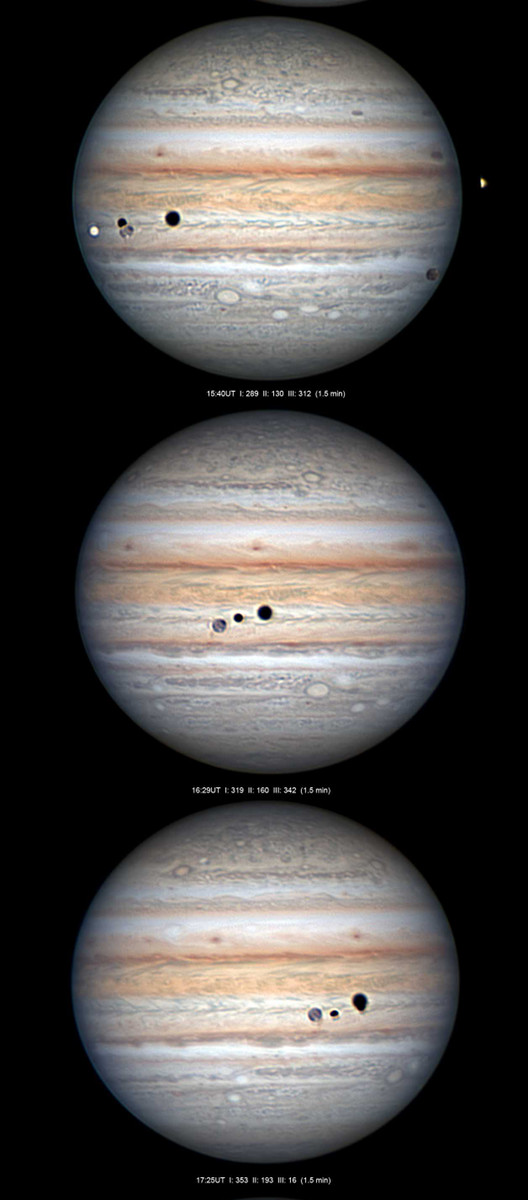
But the best way to follow the sequence of events is by video! The Washington Post put it all together along with a step-by-step guide to everything that's happening. Here's the story: Watch this ‘surreal’ Jupiter eclipse that you probably missed.
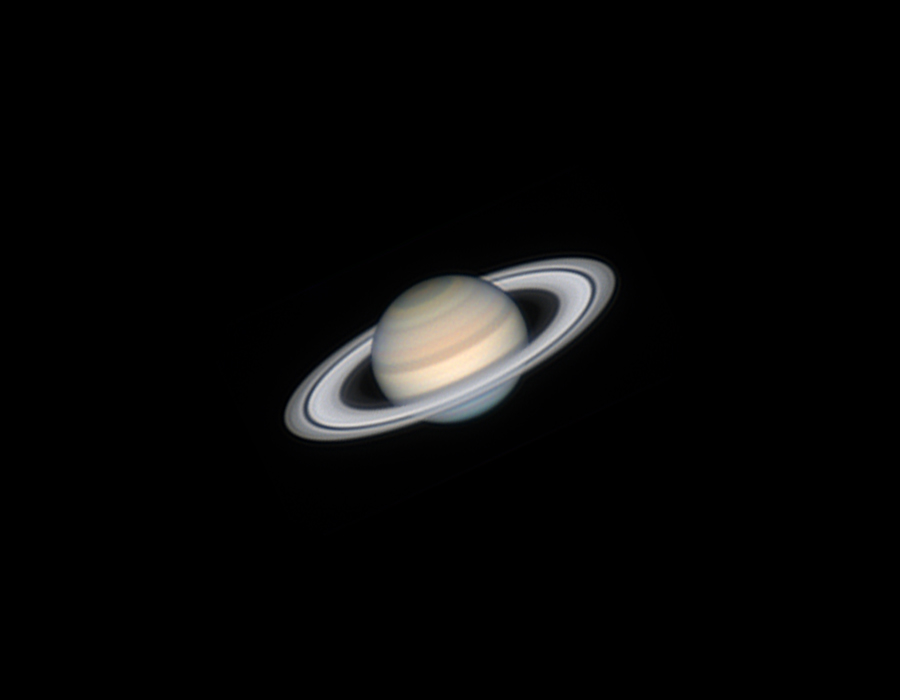
Uranus (magnitude 5.7, in Aries) and Neptune (magnitude 7.8, at the Aquarius-Pisces border) are high in the southeast to south in the early-morning hours.
All descriptions that relate to your horizon — including the words up, down, right, and left — are written for the world's mid-northern latitudes. Descriptions that also depend on longitude (mainly Moon positions) are for North America.
Eastern Daylight Time, EDT, is Universal Time minus 4 hours. Universal Time is also known as UT, UTC, GMT, or Z time. To become more expert about time systems than 99% of the people you'll ever meet, see our compact article Time and the Amateur Astronomer.
Want to become a better astronomer? Learn your way around the constellations. They're the key to locating everything fainter and deeper to hunt with binoculars or a telescope.
This is an outdoor nature hobby. For an easy-to-use constellation guide covering the whole evening sky, use the big monthly map in the center of each issue of Sky & Telescope, the essential magazine of astronomy.
Once you get a telescope, to put it to good use you'll need a detailed, large-scale sky atlas (set of charts). The basic standard is the Pocket Sky Atlas (in either the original or Jumbo Edition), which shows stars to magnitude 7.6.

Next up is the larger and deeper Sky Atlas 2000.0, plotting stars to magnitude 8.5; nearly three times as many. The next up, once you know your way around, are the even larger Interstellarum atlas (stars to magnitude 9.5) or Uranometria 2000.0 (stars to magnitude 9.75). And be sure to read how to use sky charts with a telescope.
You'll also want a good deep-sky guidebook, such as Sky Atlas 2000.0 Companion by Strong and Sinnott, or the bigger (and illustrated) Night Sky Observer's Guide by Kepple and Sanner.
Can a computerized telescope replace charts? Not for beginners, I don't think, and not on mounts and tripods that are less than top-quality mechanically, meaning heavy and expensive. And as Terence Dickinson and Alan Dyer say in their Backyard Astronomer's Guide, "A full appreciation of the universe cannot come without developing the skills to find things in the sky and understanding how the sky works. This knowledge comes only by spending time under the stars with star maps in hand."
![]() Audio sky tour. Out under the evening sky with your
Audio sky tour. Out under the evening sky with your
earbuds in place, listen to Kelly Beatty's monthly
podcast tour of the heavens above. It's free.
"The dangers of not thinking clearly are much greater now than ever before. It's not that there's something new in our way of thinking, it's that credulous and confused thinking can be much more lethal in ways it was never before."
— Carl Sagan, 1996
"Facts are stubborn things."
— John Adams, 1770
 9
9









Comments
misha17
August 27, 2021 at 10:19 am
If you are planning to view the April 8, 2024 solar eclipse locally, the upcoming Labor Day weekend will be a good opportunity to prepare your viewing locations.
On Sept 3rd, the Sun will be at decl. +7 degrees North - the same declination it will be for the Apr 8, 2024 total solar eclipse . Sunrise and sunset times are about the same for both days, so the Sun's position in the sky will be almost the same as it will be during the .eclipse.
Use the Eclipse Simulator
( Link: https://eclipse2024.org/eclipse-simulator/ )
mentioned in the Apr 8, 2021 Sky And Telescope article
( https://skyandtelescope.org/astronomy-news/t-3-years-til-the-2024-total-solar-eclipse/ )
to get eclipse times, then go outside on Sep 3rd and see where the sun will appear for Apr 8, 2024.
Since Sept 3rd falls so close to the Labor Day weekend, if folks were going to travel to nearby landmarks (parks, mtns, etc) for the eclipse, they can travel on the holiday weekend to scout out good viewing sites. The Sun's position in the sky won't vary by more than a couple of degrees over that weekend.
You must be logged in to post a comment.
New Jersey Eclipse Fan
August 27, 2021 at 7:00 pm
I know I'm hoping to travel from Central Jersey to witness the event in 2024. The most convenient locations for me would be the Great Lakes cities that fall in or near the path of totality; Cleveland, Oh.; Erie, Pa.; Buffalo and Rochester, N.Y. and Montréal, Qc. We're all familiar with "lake-effect" snow, but does that apply when it's warmer? I.e., is it foolish to plan a trip to those places above east of the Great Lakes when there is a likelihood of overcast skies?
You must be logged in to post a comment.
misha17
August 28, 2021 at 12:55 am
Lake-effect snow usually occurs in the early winter, when the lakes still have some of the heat they absorbed during the summer. The still-warm lakes give off moisture which condenses over the nearby land which has cooled more quickly, or condenses over the lakes when winds blow cold air from Canada over the lakes, and carry the clouds and condensation over the U.S. lakeshores.
By April, the lake water has cooled down and hasn't begun heating up again (there is ice fishing on the northern part of Lake Ontario when weather permits), so lake effects precipitation should be minimum.
That being said, the cooling that occurs during the eclipse might trigger some cloud cover. I went to Cabo San Lucas at the southern tip of Baja California to see the 1991 eclipse. We viewers on the beach had clear skies, but clouds formed over the nearby hills during totality from the lifted sea air cooling as the sunlight was reduced. The clouds quickly cleared out as temperatures warmed again after totality. Keep in mind there was at least a 10-degree (Fahrenheit) temperature drop from about 90 degrees (Fahrenheit) to 75-80 degrees during totality.
The final deciding factor will be wind direction - winds blowing south-to-north will blow any clouds away from the US shorelines, but wind directions will depend on if any weather systems are in play nearby.
You must be logged in to post a comment.
misha17
August 28, 2021 at 10:01 am
New Jersey Eclipse Fan:
Update - I sent a query to the National Weather Service's Cleveland Twitter account ( @NWSCle )
Their reply:
https://twitter.com/NWSCLE/status/1431578578513121287
"Lake effect clouds and snow do decrease during the spring as the surrounding air warms and the lake remains relatively cool. However this year on April 1 we saw heavy snow squalls in some areas so April snow and clouds can not be ruled out for the 2024 eclipse."
You must be logged in to post a comment.
Rfeldman
August 28, 2021 at 11:18 pm
I recommend https://eclipsophile.com/2024tse/ for 2024 eclipse weather prospects. After looking at Figures 3 & 4, I wouldn't get my hopes up too high regarding clear skies in the upper Midwest and Northeast.
You must be logged in to post a comment.
New Jersey Eclipse Fan
August 29, 2021 at 12:47 am
Thanks for your rapid responses! It sounds like I'm better off planning a trip to Little Rock, Ark. or Dallas, Tex. My wife & I traveled to Tennessee for the '17 event and had a wonderful time, thanks to the nice people at a place called Vol State Community College in the Nashville suburb of Gallatin. It was her first total solar eclipse and my second (Bucharest, Romania in August '99). I appreciate both of you doing the weather research for the '24 event, which will ultimately help in my destination determination.
You must be logged in to post a comment.
mary beth
August 29, 2021 at 7:12 pm
Spring is wonderful in Texas! Marble Falls or Kerrvile would be a very nice destination! Bluebonnets and hilly lookouts! There’s an excellent WW2 museum in Fredericksburg Texas!
You must be logged in to post a comment.
New Jersey Eclipse Fan
August 30, 2021 at 6:46 pm
Thanks for the info! I will look into further into it the closer The Big Day approaches. It might be worth heading to the Deep South just to have someone say "Y'all come back real soon now, y'hear!"
You must be logged in to post a comment.
Rod
August 30, 2021 at 7:26 am
Observed 2200-2300 EDT/0200-0300 UT. Last Quarter Moon 30-August-2021 0713 UT. Moon rise 2335 EDT/0335 UT in Taurus. Some enjoyable viewing using the 14-mm at 71x with true FOV about 1-degree. At Jupiter I could see cloud belts, 4 Galilean moons, and 8th to 11th magnitude stars visible in the FOV. Near 2219 EDT, a meteor streaked south near Jupiter. It was bright, almost as bright as Jupiter so I estimate about mv -2.0. Saturn with rings and Titan moon visible. More faint stars visible in the FOV some 10th to 11th apparent magnitude according to Starry Night and Stellarium. Two stars I could see showed apparent magnitudes mv + 11.40. An enjoyable time viewing. Distant lightening flashed above the horizon tonight, distant thunderstorms near Lynchburg VA area. I could not see the lightening but low level, flashes of light above the horizon. https://www.wunderground.com/ showed the storms near Lynchburg VA while I was out viewing along Patuxent river area in MD. Jupiter and Mu Capricorni star visible together in the FOV, about 33 arcminute angular separation this evening. Limiting magnitude check. I could see the stars of Delphinus. Zeta, Eta, and Kappa Delphini stars visible. Eta near 5.37 or 5.35 apparent magnitude and hints of Milky Way running from Cygnus high over head through Sagittarius.
You must be logged in to post a comment.
You must be logged in to post a comment.